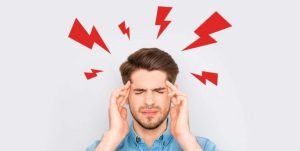Overview
Headache is a common complaint seen in approximately 90% of the population. Migraine, which is among the primary headaches, is a type of persistent or recurrent headache that can begin at any age. However, the first attack of migraine usually starts at puberty roughly 12-13 of age or early 20s. The study supports the idea that migraine most likely improves, as getting older.
Migraine is reported to be the 3. most common illness in the world. What’s more, this ailment is 3 times more prevalent in women than men. And, another report tells us that this health problem is affecting 1 in 5 women while this number is 1 in 15 men.
Based on the above-given data, it is safe to say that migraine is quite a common health problem. According to the World Health Organisation; this type of headache is ranked 19th in the list of diseases that inhibits the workforce in the world.
Migraine Definition
As mentioned in the above section, migraine is one of the illnesses that reduce the quality of life. Most migraine attacks are severe. And this severity differs migraine headaches from other types of headaches. In addition to that, nausea, and sensitivity to sound and light accompany the headache pain.
Migraine definition: it generally starts in the neck, temple or around the eyes and may get worse as the person moves. In general, the pain shows itself with throbbing pain.
Another point is migraine -usually- affects 1 side of the head and often comes in attacks. These attacks can be as long as 4 to 72 hours.
Causes
Like cancer and diabetes, the exact cause of migraines is not known. However, scientists/doctors think that environmental and genetic factors play role in the development of this illness.
Imbalances in brain chemicals, including serotonin, are thought to be the cause of the attacks. These imbalances cause changes in the nerves and blood vessels in the brain and bring about migraine.
Why a person has a migraine while the other person doesn’t is explained by the differences in the nervous system. Those who have migraine problems have a more sensitive nervous system, therefore they are more susceptible to developing a migraine.
Environmental factors can trigger this sensitive nervous system. This circumstance causes dilation of blood vessels in the brain and inflammation of the nerves thus causing migraine.
Even though experts do not know the exact cause of this headache type, they are certain about the triggering factors of migraine.
Migraine Triggers
To begin with, it is safe to say that the triggering factors vary from person to person. A factor that triggers migraine in a patient may not cause any problem to another.
Nevertheless, it is quite important for patients to be able to identify the triggering factors. In doing so, the patient can prevent some attacks, which occur due to triggering factors.
Please note that avoiding triggering factors can significantly reduce the number of attacks but do not completely stop them.
These are the general triggers
- Hunger
- Stress
- Sleep Problems
- Caffeine
- Smoking
- Second-hand Tobacco
- Hormonal Changes in women
- Strong Smells ( perfume )
- Changes in Altitude
- Air Pollution
- Poor Posture
- Foods ( such as chocolate, avocados, onions, garlic, bananas, cheese and MSG-added foods)
- Strong wind
- Bright Light
- Intense Exercise
Symptoms
Even though many people consider a migraine a headache that suddenly starts, a migraine has different periods from the beginning to the end.
In fact, there are 4 different phases. At each period the patient experience different symptoms. These phases are; the prodrome, the aura, the headache and the postdrome. Nonetheless, it is not guaranteed that a patient experiences all of the stages.
Prodrome Period :
Everything starts with the prodrome period. A day or two before the beginning of the headache, patients may notice minor changes and warnings for the upcoming migraine attack.
The increased need for urination, food cravings, irritability, frequent yawnings, depression and fatigue are among the symptoms that may emerge at this stage.
Aura :
Another symptom is “aura”. The neurological symptoms that may emerge right before a migraine are entitled “Aura”. Many of the patients don’t go through an aura.
An Aura can be both visual and sensorial. Usually, this phase is short, taking approximately 20 minutes. In this phase the patient may experience changes in his/her sight, seeing flashing lines as well as zig-zag lines, in short, the patient experience visual hallucinations.
In addition to these, language problems – difficulty reading and speaking- numbness and tingling sensation that may occur anywhere on the body, and muscle weakness can be experienced by the patient.
Attack :
The severity of the attacks varies from person to person and headache attacks ( in general ) last 3 to 72 hours. The headache, in most patients, starts slowly and gradually increases. The pain is a throbbing pain like a heartbeat which usually starts in one part of the head.
During the attack; the patient may experience nausea – vomiting, excessive sensitivity to light/sound or even touch, blurred vision, dizziness and in some cases fainting. The symptoms can get worse if the person moves.
Postdrome :
Postdrome, as the name implies, is the period that starts after the attack. In this stage, the patient feels exhausted, tired and relaxed due to the reduction of the pain.
Moreover, some patients may desire to eat sweets or may experience the urge to urinate in this stage. These post-attack behaviours can help doctors to diagnose the presence of migraine.
Treatment
The drugs used in the treatment of migraine can help to eliminate the pain during headache attacks, stop the accompanying symptoms such as nausea and vomiting or reduce the frequency of headache attacks.
There are two types of treatment methods for migraine. The first one is the treatment that deals with the pain ( headache ) or the accompanying symptoms such as nausea and vomiting.
To ease these symptoms, patients use some drugs mainly painkillers. Additionally, other drugs which can ease the nausea-vomiting can help the patient overcome the attack.
Your doctor will prescribe the most appropriate medication for your migraine attack.
The second one is preventative treatment. This treatment method is applied if the migraine is frequent enough to affect the patient’s daily life.
At first, doctors suggest patients stay away from the above-given triggers to reduce the frequent migraine attacks.
If this method doesn’t show a positive effect, then the doctor prescribes some medications used in the treatment of blood pressure, epilepsy and depression problems. For the best results, the medicine ( prescribed by the doctor ) must be used daily.
Tarkan is an experienced health writer ( currently more than 600 articles ) and also the founder of this website namely www.neededforhealth.com. His expertise in health stems from in-depth medical research and knowledge which he obtained over the course of many years.
Tarkan enjoys sharing factual knowledge on health, psychology and nutrition. He always aims to deliver evidence-based recommendations, provide links to related scientific studies.





